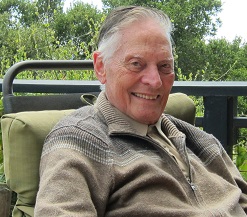Geoffrey Chew facts for kids
Quick facts for kids
Geoffrey F. Chew
|
|
|---|---|

Chew at his California home on July 2014
|
|
| Born | June 5, 1924 Washington, D.C., United States
|
| Died | April 12, 2019 (aged 94) Berkeley, California, United States
|
| Alma mater | University of Chicago |
| Known for | S-matrix theory, bootstrap theory, strong interactions, Chew–Frautschi plot |
| Awards | Hughes Prize (1962) Lawrence Prize (1969) Majorana Prize (2008) |
| Scientific career | |
| Fields | Theoretical physics |
| Institutions | University of Illinois UC Berkeley |
| Doctoral advisor | Enrico Fermi |
| Doctoral students | David Gross John H. Schwarz John R. Taylor |
Geoffrey Foucar Chew (born June 5, 1924 – died April 12, 2019) was an American theoretical physicist. This means he studied the ideas and math behind how the universe works. He is famous for his bootstrap theory of strong interactions.
Contents
About Geoffrey Chew
Geoffrey Chew was a professor of physics at the UC Berkeley starting in 1957. He became a professor emeritus in 1991, which means he retired but kept his title.
Early Life and Education
Chew earned his PhD in theoretical particle physics from the University of Chicago. This was between 1944 and 1946. From 1950 to 1956, he taught physics at the University of Illinois.
Achievements and Students
Chew was a member of important groups like the National Academy of Sciences. He was also a founding member of the International Center for Transdisciplinary Research (CIRET).
He was a student of the famous scientist Enrico Fermi. Many of Chew's own students became very successful. One of them was David Gross, who won the Nobel Prize in Physics in 2004. Another student, John H. Schwarz, helped create string theory.
Chew's Work in Physics
Geoffrey Chew was a leader in an idea called the S-matrix approach. This approach helped scientists understand the strong interaction. The strong interaction is one of the four basic forces in nature. It holds the tiny parts of atoms together.
The Bootstrap Principle
Chew also developed the bootstrap principle. This idea was very popular in the 1960s. He led a group of scientists at the University of California, Berkeley who worked on it.
The S-matrix theory tried to understand how particles interact. It looked at how they scatter off each other. It did this without assuming that particles are tiny points.
Particles and the Chew–Frautschi Plot
In 1961, Chew and his helper Steven Frautschi made an important discovery. They noticed that certain particles, called mesons, fit into families. These families showed a pattern on a special graph. This graph is called the Chew–Frautschi plot.
On this plot, the square of a meson's mass was directly related to its spin. Spin is a property of particles, like a tiny internal rotation. This pattern was the same for all families of mesons.
Nuclear Democracy Idea
This discovery led to a big idea: none of the strongly interacting particles are truly elementary. Instead, they are all made up of each other. This was a new way of thinking about particles.
Chew's idea was that there might be a new kind of theory. This theory would describe interactions of particles that have no point-like parts at all. This approach was sometimes called nuclear democracy. It meant that no single particle was more "basic" or "elementary" than another.
Impact and Legacy
The S-matrix approach to strong interactions was later replaced by a different theory called quantum chromodynamics. However, the ideas from Chew's work were still important.
A consistent theory for how particles scatter, based on his ideas, was eventually created. Today, this is known as string theory. Edward Witten, another famous physicist, later connected S-matrix theory to the holographic principle.
Awards and Recognition
Geoffrey Chew received several important awards for his work.
- In 1962, he won the Hughes Prize from the American Physics Society. This was for his bootstrap theory of strong interactions.
- He also won the Lawrence Prize in 1969.
- In 2008, he received the Majorana Prize.

